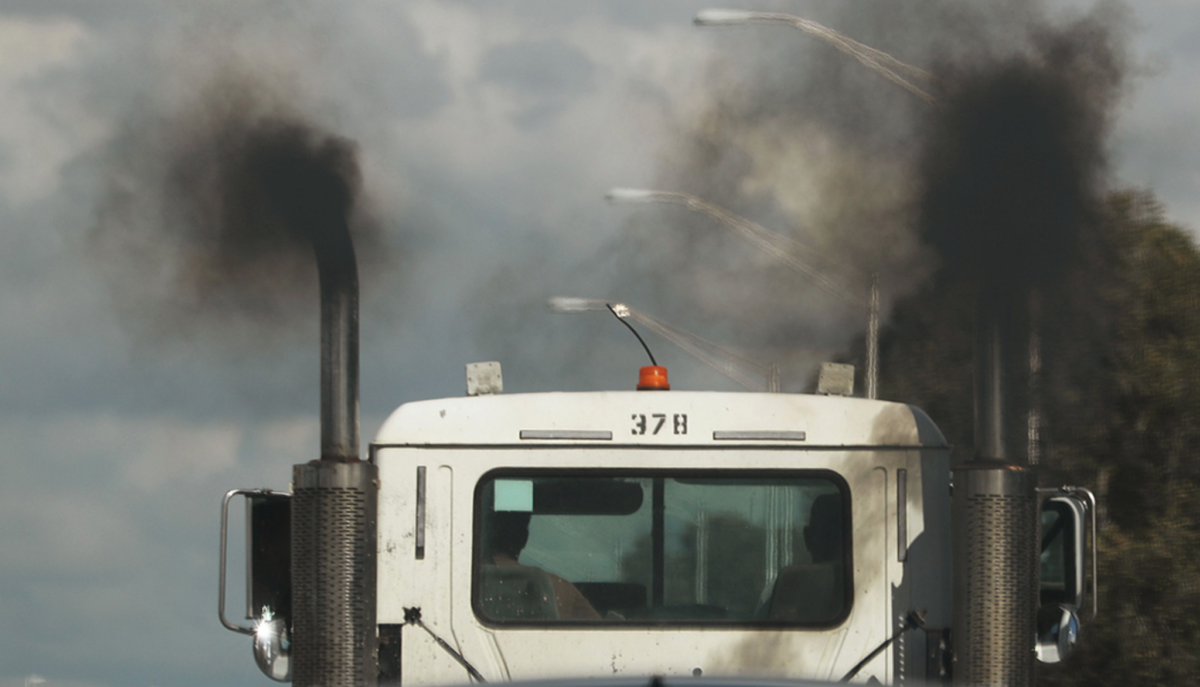Staff Report –
WASHINGTON, D.C. — The Biden administration announced the most ambitious federal vehicle emissions standards ever on Wednesday that will accelerate the ongoing transition to a clean vehicles future by requiring that two-thirds of new passenger cars and a quarter of new heavy trucks sold in the United States are all-electric by 2032.
If the two rules are enacted as proposed, they would put the world’s largest economy on track to slash its planet-warming emissions at the pace that scientists say is required of all nations in order to avert the most devastating impacts of climate change, and it would be nothing short of a revolution in the U.S. auto industry.
The announcement came from the Environmental Protection Agency (EPA), which says the new, tougher regulations would improve air quality for communities across the nation, especially poor, minority communities that have borne the brunt of polluted air for decades. When implemented, the rules would help the U.S. avoid nearly 10 billion tons of CO2 emissions, equivalent to more than twice the total U.S. CO2 emissions in 2022, while saving thousands of dollars over the lives of the vehicles meeting these new standards and reduce America’s reliance on approximately 20 billion barrels of oil imports.
“By proposing the most ambitious pollution standards ever for cars and trucks, we are delivering on the Biden-Harris Administration’s promise to protect people and the planet, securing critical reductions in dangerous air and climate pollution and ensuring significant economic benefits like lower fuel and maintenance costs for families,” said EPA Administrator Michael S. Regan. “These ambitious standards are readily achievable thanks to President Biden’s Investing in America agenda, which is already driving historic progress to build more American-made electric cars and secure America’s global competitiveness.”
Since President Biden took office, the number of EV sales has tripled while the number of available models has doubled. There are over 130,000 public chargers across the country – a 40 percent increase over 2020. The private sector has also committed more than $120 billion in domestic EV and battery investments since President Biden signed the Inflation Reduction Act into law. The proposed standards reflect the advancements and investments in clean vehicle manufacturing, which have been accelerated by President Biden’s Investing in America agenda and complement the ongoing transition in the market towards cleaner vehicles.
The new proposed emissions standards for light-, medium-, and heavy-duty vehicles for model year (MY) 2027 and beyond would significantly reduce climate change due to global warming from the burning of fossil fuels for energy and transportation, as well as other harmful air pollution, unlocking significant benefits for public health. At the same time, the proposed standards would lower maintenance costs and deliver significant fuel savings for drivers and truck operators.
Through 2055, EPA projects that the proposed standards would avoid nearly 10 billion tons of CO2 emissions (equivalent to more than twice the total U.S. CO2 emissions in 2022). The proposed standards would reduce other harmful air pollution and lead to fewer premature deaths and serious health effects such as hospital admissions due to respiratory and cardiovascular illnesses.
By accelerating adoption of technologies that reduce fuel and maintenance costs alongside pollution, the proposed standards would save the average consumer $12,000 over the lifetime of a light-duty vehicle, as compared to a vehicle that was not subject to the new standards.
The new standards would also reduce oil imports by approximately 20 billion barrels, and overall, EPA estimates that the benefits of the proposed standards would exceed the cost by at least $1 trillion.
The first set of standards, the “Multi-Pollutant Emissions Standards for Model Years 2027 and Later Light-Duty and Medium Duty Vehicles,” builds on EPA’s existing emissions standards for passenger cars and light trucks for MYs 2023 through 2026. The proposal retains the proven regulatory design of previous EPA standards for light-duty vehicles, but leverages advances in clean car technology to further reduce both climate pollution and smog- and soot-forming emissions.
Between 2027 and 2055, the total projected net benefits of the light- and medium-duty proposal range from $850 billion to $1.6 trillion. The proposal is expected to avoid 7.3 billion tons of CO2 emissions through 2055, equivalent to eliminating all greenhouse gas emissions from the entire current U.S. transportation sector for four years and would also deliver significant health benefits by reducing fine particulate matter that can cause premature death, heart attacks, respiratory and cardiovascular illnesses, aggravated asthma, and decreased lung function. EPA analysis shows that severe health impacts related to particulate matter exposure will also be reduced – including lung disorders (including cancer), heart disease, and premature mortality.
EPA’s proposal considers a broad suite of available emission control technologies, and the standards are designed to allow manufacturers to meet the performance-based standards however works best for their vehicle fleets. EPA projects that for the industry as a whole, the standards are expected to drive widespread use of filters to reduce gasoline particulate matter emissions and spur greater deployment of CO2-reducing technologies for gasoline-powered vehicles.
The proposed standards are also projected to accelerate the transition to electric vehicles. Depending on the compliance pathways manufacturers select to meet the standards, EPA projects that EVs could account for 67 percent of new light-duty vehicle sales and 46 percent of new medium-duty vehicle sales in MY 2032.
The proposed MY 2032 light-duty standards are projected to result in a 56 percent reduction in projected fleet average greenhouse gas emissions target levels compared to the existing MY 2026 standards. The proposed MY 2032 medium-duty vehicle standards would result in a 44 percent reduction compared to MY 2026 standards.
The second set of proposed standards, the “Greenhouse Gas Standards for Heavy-Duty Vehicles – Phase 3,” would apply to heavy-duty vocational vehicles (such as delivery trucks, refuse haulers or dump trucks, public utility trucks, transit, shuttle, school buses) and trucks typically used to haul freight. These standards would complement the criteria pollutant standards for MY 2027 and beyond heavy-duty vehicles that EPA finalized in December 2022 and represent the third phase of EPA’s Clean Trucks Plan.
These “Phase 3” greenhouse gas standards maintain the flexible structure that EPA previously designed through a robust stakeholder engagement process to reflect the diverse nature of the heavy-duty industry. Like the light- and medium-duty proposal, the heavy-duty proposal uses performance-based standards that enable manufacturers to achieve compliance efficiently based on the composition of their fleets.
The projected net benefits of the heavy-duty proposal range from $180 billion to $320 billion. The proposal is projected to avoid 1.8 billion tons of CO2 through 2055, equivalent to eliminating all greenhouse gas emissions from the entire current U.S. transportation sector for an entire year, and deliver additional health benefits by reducing other pollutants from these vehicles.\
The standards would result in improved air quality nationwide, and those who live near major roadways and are disproportionately exposed to vehicle pollution and heavy-duty activity, which often includes low-income populations and communities of color, would benefit most directly.
The proposed standards align with commitments made by automakers and U.S. states as they plan to accelerate clean vehicle technologies in the light- and medium-duty fleets in the next 10 to 15 years. Car and truck companies are moving to include electric vehicles as an integral and growing part of current and future product lines, leading to an increasing diversity of clean vehicles for consumers.
These developments are bolstered by President Biden’s investments in America, which provide unprecedented resources to support the development and market for clean vehicle technologies and associated infrastructure and represent significant investment in expanding the manufacture, sale, and use of zero-emission vehicles. As these technologies advance, battery costs continue to decline and consumer interest in electric vehicles continues to grow.
President Biden’s legislative accomplishments are also supporting critical generation of clean electricity and production of clean hydrogen needed to decarbonize transportation. EPA considered this rapid innovation in its assessment that tighter emissions standards are feasible.
EPA’s proposals are informed by robust and inclusive stakeholder engagement with industry, labor, advocates, and community leaders. EPA’s proposals will be published in the Federal Register and available for public review and comment, and the agency will continue to engage with the public and all interested stakeholders as part of the regulatory development process.
For more information on the new standards, other transportation issues and environmental justice, see EPA’s Website.
___
If you support truth in reporting with no paywall, and fearless writing with no popup ads or sponsored content, consider making a contribution today with GoFundMe or Patreon or PayPal. We just tell it like it is, no sensational clickbait or pretentious BS.














